
 Just a few of the cool Mustangs our customers have. |
Last year the car went 10.94 at 126 mph in the 1/4 mile with 500 rear wheel horsepower. Update fall 2010: Congtatulations to Lou for Running 10.04 @ 134 mph with his new forged internals and Kenne Bell Mammoth supercharger! Click on Lou's name(above)to see more pictures and videos of his car |
Click on Joe's name(above)to see his time slip |
John’s car has been upgraded with Stainless Works headers and 3 inch exhaust system, a ported supercharger, larger intercooler heat exchanger, billet supercharger and tensioner pulleys, SCT Tuning by Realspeed and a few other goodies, good for 525 hp to the rear wheels our in-house Mustang Dyno. The suspension has also been upgraded with Steeda full-length subframe connectors, Eibach springs and bushings and braces for the differential to eliminate wheel hop. |
Here as an example is Dan Carlson’s daily driver 1990 Mustang GT. This car runs 10.46 at 132 in the quarter mile and gets driven about 18,000 miles a year. It has fully street-able suspension that can handle curves as well as straight lines. It has a fully muffled exhaust system with catalytic converters, Air Conditioning, CD player, sunroof, etc., and is even occasionally used to pick up the kids from pre-school. CLICK on link to see a video and timeslip from the track: (Car number 15, in the right lane). The car is driven to and from the track - Over 260 miles round trip. No trailer. No support vehicles - just a true 10-second daily driver. |
This car is the ultimate no-compromises street-car, with 800 rear-wheel horsepower on 93 Octane gas. It has air conditioning, power steering, power brakes, Maximum Motorsports tubular K-member, Steeda 5-Link-2 rear suspension with custom suspension modifications by Realspeed, and Kinese 18 inch wheels with super sticky rubber. |
|
Engine: Ponydown T70 turbo kit with a tial 38mm wastegate and an RFL blow off valve,GT-40 intake, 70mm tb, 75mm MAF, 42lb injectors Anderson PMS engine management tuned by Realspeed Automotive Suspension: Sub-frame connectors, tubular front end, Front coil overs, MM rear springs, BBK rear control arms and caster camber plates Brakes: Lincoln Mark 7 calipers, EBC brake pads, SS brake lines,power slot rotors Cooling: 3 row alum. radiator, dual fans Driveline: T-56 transmission, Mcleod clutch |
Jim is active on LIStangs and the Yellow Mustang Registry, where his screen name is Just Cruisin Dyno tuned by Realspeed |
7/20/17 
How much Power are Comp Stage 3 cams worth in a Coyote mustang? Well that might depend on who tunes the car after the installation. Realspeed tuned a customer's 2013 Mustang GT last fall when it was equipped with a Boss intake manifold, Steeda cold air intake, BBK throttle and BBK headers. After that he had Comp Stage 3 cams installed and tuned at another shop. Unsatisfied with the performance of the car after the cam install, he brought the car to a third shop, where they fixed a few issues and dyno tuned the car again. The customer reports that the car ran better after the third shop retuned it than it did when it left the install shop, but it still seemed disappointing. Suspecting there was more power to be gained, he brought the car back to Realspeed for a check on our Mustang Dyno. After dyno testing the car as it arrived back at Realspeed with the new cams and the third shop’s tune, Realspeed retuned the car. *The red line on the graph is the power the car made on the Realspeed Mustang Dyno last fall with the stock cams. *The green line on the graph is the power the car made on the Realspeed Mustang Dyno when it arrived back with the new Comp cams and the third shop’s tune. *The blue line on the graph is the power the car made on the Realspeed Mustang Dyno with the new Comp cams and a Realspeed tune. These power gains were made by optimizing the variable cam-timing and electronic-throttle settings to optimize airflow with the new cams. It should be noted that the air fuel ratio and ignition timing settings were very similar for all three tunes shown on the graph. Of course there is more to a good tune than just full throttle power numbers. With the Realspeed tune this car drives smoothly, has a steady idle, and retains factory safety features such as exhaust over-temperature protection and factory knock sensor sensitivity and protection limits. 7/23/2016 
We baselined this Terminator Cobra, with a ported stock supercharger and 2.76” pulley, monoblade throttle, SCT BA2600 MAF sensor, JLT cold air intake, Bassini midpipe, and 60lbs injectors on our dyno at 477rwp and 461 ft-lbs of torque. Next, with a newly installed 2.3L Whipple making 20 lbs of boost, ID1000 fuel injectors, and a “return style” fuel system, the Cobra put down 566 rwhp and 493 ft-lbs of torque on a safe conservative tune. Then we emptied the gasoline and filled the tank with E85. With no other changes except changing the fuel setting in the tune for E85 the car picked up about 30 horsepower. Next, a few more tweaks were added to dial in for the E85 and we dyno’d this corn fed snake at 617rwhp and 519 ft-lbs of torque, again with a fairly conservative tune. With the proper fuel system, this was a gain of 51 horsepower in the time it takes to refill a fuel tank with E85 and upload a tune. 12/30/15  This week’s featured tune was done on a really clean supercharged 2008 Saleen. By optimizing the variable cam timing in the tune we were able to pick up 36 horsepower while improving airflow and reducing boost (intake manifold backpressure). This nice increase in power and drop in boost was accomplished with no mechanical changes to the car whatsoever. It was all in the tune! Furthermore, scanning the old tune revealed that the previous tune had the knock sensors disabled and a very aggressive timing curve at low rpm. By optimizing the cam timing and the air/fuel ratio we were able to make power with the same or less ignition timing at all points on the power curve. So while power increased, the new the tune is actually safer. 3/11/15  Today's dyno results: A 2005 Vortech supercharged mustang with a Realspeed tune vs the tune it came in with from somewhere else... A nice easy 72 horsepower gain without even trying to make big power. 2/6/14  Final results from installing headers & cams and a Realspeed tune on a 2014 GT500: We picked up 104 horsepower! The boost increased at low rpm and decreased at high rpm. The low rpm boost increase is due to improved throttle angle from the Realspeed tune. (The computer controls the throttle angle). The high rpm boost decrease comes from more efficient airflow through the engine due to the cams and headers. These results are with the stock supercharger pulley, stock throttle body and stock fuel system. For information about dyno tuning your car click here 1/2/14  This 2006 Mustang GT with a Kenne Bell supercharger came to us for a “tune evaluation” consulting session. It had been built and tuned by a well known shop, but the owner felt the drivability was poor and wanted us to check it out. Initial dyno tests revealed that the tune was relatively safe - a little on the rich side but nothing excessive enough to explain the low power numbers. Further datalogging revealed that the variable cam timing settings were not optimized for best performance and the ignition timing left a lot of room for improvement. Realspeed spent the day retuning it and the result was an improvement of 62 horsepower and 49 ft/lb. Throttle response and overall smoothness were also improved. 9/27/11  Our last featured tune was a 2007 Mustang GT making 500 rear-wheel horsepower. Under the hood the polished supercharger and billet accessories look as good as the car is fast. Surrounded by all the polished and billet aluminum, the drab looking stock cast throttle really stuck out, and not in a good way. To complete the look of the engine compartment we added a Ford Racing billet throttle. With the larger throttle blades letting in more air, a retune was in order. Knowing the engine was near its limit for making safe power, the car owner opted to throw a splash of Sunoco 260GT 100 octane unleaded on top of the 93 octane that was in the tank. This effectively raised the octane in the tank to about 95. As a side note, Sunoco 260 GT** is the race fuel we prefer when a little extra detonation protection is desired for a street car which usually runs on 93 octane. Race fuels vary tremendously in composition from one brand to another, and also with different grades from the same brand. Some race fuels burn at a stoichiometric ratio of 15:1 and some have a stoichiometric ratio as low as 13.4:1. This means that adding race fuel to a street car may richen or lean the mixture, depending on the fuel used. Sunoco 260 GT has a stoichiometric ratio of 14.0:1, which is very close to the 14.09:1 ratio of the ethanol blended fuels coming from the gas pump these days. In addition, the lead in some race fuels quickly ruins the oxygen sensors which are so critical to good gas mileage and fuel mixture control in modern cars. Sunoco 260GT has 100 octane but has no lead. Combined with a stoichiometric ratio that is nearly identical to pump gas, this makes it an ideal fuel to add to your street car when extra detonation protection is desired for hard use at the race track or to allow a more aggressive tune. [** Update 9/2016: Sunoco 260 GT is no longer available from our local supplier, but we have been having good results with VP MS100, shich has a fairly similar stoichiometric ratio] With about three gallons of 100 octane added to seven gallons of 93 octane in the tank, the car was put back on the dyno. The larger FRPP throttle let in more air to the supercharger, increasing peak boost 1.2 psi to 12.5 lbs. After a few adjustments to the tune, power increased from 500 to 534 at the rear wheels. The tune was also re-mapped for smoother part throttle operation with the larger throttle. For information about dyno tuning your car click here 7/14/11  Our latest featured tune is a 2007 Mustang with a Ford Racing/Whipple supercharger. The car put down 500 rear wheel horsepower on our Mustang Dyno with nothing more that the components supplied with the supercharger kit, a set of long tube headers, Mac mufflers and a Realspeed tune. For comparison, a stock 2007 GT usually puts down 275 rear wheel horsepower. So the supercharger, headers and tune were good for about 225 additional horsepower. 500 horsepower is pushing the strength limit of the stock connecting rods and pistons, so the car was detuned down to 485 rwhp for street use to keep things safe. 1/19/11  Here is another example of Realspeed dyno tuning vs. a mail-order tune. This 2011 Mustang GT came in to Realspeed equipped with a Steeda cold air intake, Corsa X-pipe and mufflers, and an SCT Xcalibrator3 tuner from a big mail-order parts supplier. The mail-order tuner came with three tunes installed and more “free tunes for life”. Not completely satisfied with his mail-order tune, the customer decided to bring it to Realspeed for a custom tune. The customer wanted the most power possible so he had already programmed the mail-order “Race” tune into his car’s computer. We ran it on the dyno 3 times with the mail-order race-tune to get a consistent baseline before going to work on the Realspeed custom dyno tune. The mail-order tune’s best run peaked at 390.2 rwhp and 367 ft/lb torque. The finished Realspeed tune peaked at 404.7 rwhp and 378.9 ft/b torque. That’s a gain of 14.5 hp and 11.9 ft/lb over the supposed “race” tune offered for “free” with their mail-order tuner. (Sometimes you get what you pay for.) These runs were done on the same day, at the same coolant temperature and air temperature, and over the same rpm range. 12/28/10  We have more test results from the Trick Flow’s Twisted Wedge 4.6L 2-Valve heads, and they look good. On this car we picked up 44.6 horsepower with just the addition of the Twisted Wedge heads and accompanying larger fuel injectors & MAF. The car had previously been tuned at Realspeed and made a best of 292 rwhp on our Mustang Dyno. After installing the TrickFlow heads and retuning, the car put down 336 rwhp. Torque was up too, from a peak of 303 before to 331 after the head swap. What was really nice was that the car gained power everywhere from 2000 rpm to redline. Unlike some upgrades where you trade away low rpm power to make more power at high rpm, this car responded with big gains up top and still managed to run stronger down low. The car was already equipped with an Accufab throttle and plenum, VT stage 2 cams, long tube headers and a stock intake manifold before the head install. The MAF sensor was upgraded to a 90mm Lightning unit and the fuel injectors were changed to 30 lb/hr to support the extra power the new heads would produce. For information about dyno tuning your car click here 11/19/10  This “tune-of-the-week” is a 1986 Mustang converted to EEC IV Mass Air with an A9L processor. It has Tri State aluminum cylinder heads, a B303 cam, 30 lb injectors, an 80mm Pro-M Mass Air Meter and the rest of the typical bolt on performance parts. What makes this car our Tune-of-the-week is how much it surprised us on the dyno. We test-drove the car before tuning it and it felt pretty good. It had none of the common tell-tale signs of a car that needs a tune. Everything felt pretty good, with no obvious flat-spots in the power curve. The ignition timing and fuel pressure were already set to the usual best-spot for making good power. Honestly, we were a little bit skeptical that the car would improve that much with a tune. Then we put it on the dyno and began tuning it. Immediately it was apparent that the car was too lean at full throttle, especially at lower rpm. While the car felt OK, it was nowhere near reaching its full potential. After tuning the car, peak horsepower improved from 302rwhp to 312rwhp and torque went from 312 to 320. But that doesn’t tell the whole story. It wasn’t just the peak numbers that improved. The car made more power everywhere, with the biggest gains occurring from 2000 to 4000 rpm, where the engine spends most of its time. At 2500 rpm alone the car gained 38 ft lbs of torque! Even though the car felt OK before, driving the car afterwards there was a huge improvement it. It just goes to show, you never know for sure until you get the car on the dyno. 11/3/10  This “tune-of-the-week” is a test of the Edelbrock E-Force supercharger on a 2007 Mustang GT. Before installing the supecharger, the car was run on the dyno to establish a baseline. With a BBK cold air intake, Pypes mufflers and a tune, the car put down 284 horsepower to the rear wheels. Installing the E-Force supercharger (Part # 1580) resulted in 394 horsepower using the tune supplied by Edelbrock, but the car was lean and the knock sensor began retarding spark timing as the engine got warmer. This caused a drop down to 388 horsepower by the second dyno run. After Realspeed called Edelbrock to verify that everything supplied with the kit was up to specification and installed correctly, the car owner decided to have Realspeed perform a custom dyno tune. Retuning the car produced 418 horsepower with smooth drivability and no knocking detected by the knock sensor. The car gained 24 horsepower and 22 ft/lb torque from the Realspeed tune, and was up 134 rear wheel horsepower from when it arrived before the supercharger installation. We apologize for the broken picture links below. As soon as we can find the time to get off the dyno and back into the office we will begin work on restoring the graphs.... 5/29/13 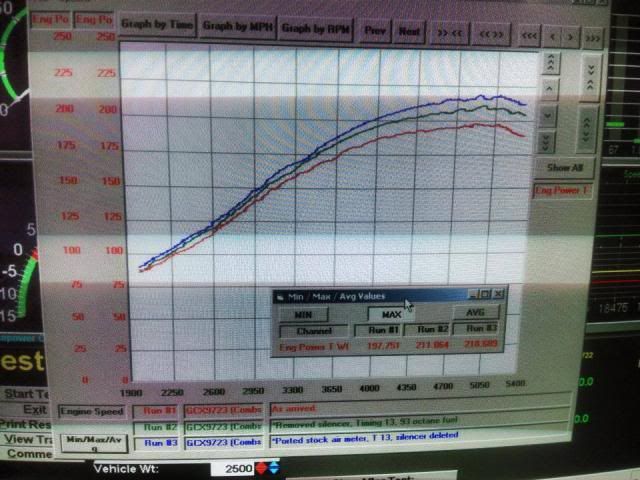 It's been awhile, but it's time to introduce our newest Featured Tune. This one won't wow you with huge horsepower numbers, but it had us here at the shop feeling a bit nostalgic. There aren't too many factory-stock Fox-Body Mustangs out there anymore, so it was a lot of fun to get one onto the dyno to perform a few of the classic "10-Minute Tune Up" tricks on an unmolested Fox. Tim brought us his very clean 1992 LX 5.0 Convertible a few months ago for some suspension upgrades and now it was time to squeeze a few more ponies out of the stock 5 liter. Granted, Tim's car is actually about 95% stock, as it does feature shorty headers, a catalytic x-pipe and a Flowmaster cat-back. Hey, stockers are hard to find, remember! The bright red LX ragtop was strapped down and a baseline run was made. It laid down 197.7 horsepower at the wheels, right where it should have been. Still healthy after 21 years. The crew jumped right in and removed the stock air-silencer and set the ignition timing to 13 degrees BTDC. The second run showed us a gain of almost 14 horsepower, for a total of 211.0. Lastly, we tried the old trick of installing a ported factory mass airflow meter housing. This simple swap gained us 7 more horsepower by itself, and the bright red LX left us with a total of 218.6 horsepower at the wheels. It was surprising that the old Fox responded so well to such basic adjustments. It was like being transported back to 1992! Three quick runs, a few simple adjustments, 21 horsepower gained. One horsepower for every year it's been on the road. Not bad. 10/9/10  This “tune-of-the-week” is a 2007 Mustang GT with “built” short block, ported heads and a Kenne Bell 2.8L Mammoth liquid cooled supercharger with a huge single-blade oval throttle. It was originally dyno tuned by another shop, but the throttle response, idle and cold-start performance were poor. You could really tell things just weren’t right as the computer attempted to control an engine that was much different from what left the Ford factory. In today’s modern Mustangs, the opening of the throttle is not directly controlled by movement of the driver’s foot on the gas pedal. Instead, the computer uses “throttle by wire” technology to control the actual opening angle of the throttle based on many layers of calculations, including variable cam angle, estimated manifold pressure, engine rpm, vehicle speed, and even catalytic converter performance at startup. This “throttle by wire” system can make throttle response unpredictable when the car is heavily modified with a supercharger and larger throttle body. Often the car will be “jumpy” and also have “dead spots” where the throttle response is poor. The 2007 Kenne Bell supercharged GT was suffering from all of these problems, and more. After a few attempt to have the other tuner fix things, the owner brought the car to Realspeed for a retune. As an SCT certified “Calibrator” tuning shop, Realspeed is trained and has access to the “throttle by wire” tuning tables, access that many other shops don’t have. We not only fixed the “throttle by wire” problems that the car was having, but the Realspeed tune also produced better fuel economy and a more stable air/fuel ratio at full-throttle and part-throttle. The icing on the cake: The Realspeed tune produced more power. |
| For information on dyno tuning your car click here 8/31/10 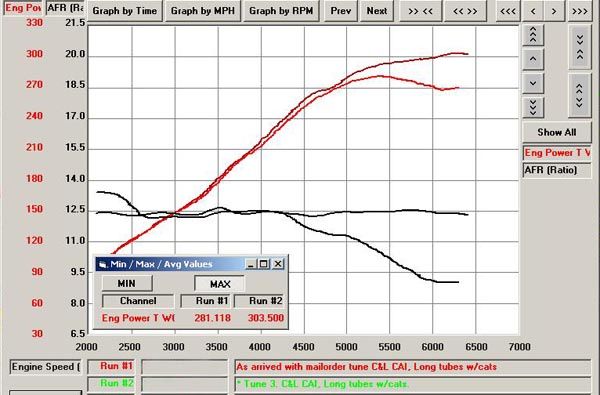  This dyno tune-of-the-week is perfect example of why custom dyno tuning is superior to mail-order tuning. Chris originally brought us his us his 2008 Mustang GT because his mail-order tune was preventing internal emissions monitor checks from completing, so he couldn’t pass the NY emissions inspection inspection. Other than that, he thought the car ran fine. When we put the car on the dyno, however, it was a different story. At high rpm the air fuel ratio went extremely rich, costing him a lot of horsepower. In fact, the car went so rich that it pegged our air fuel ratio meter at the bottom of the scale. With that rich of an A/F mixture washing down the cylinder walls with gasoline, damaging the rings and diluting the oil become a concern. In addition, the knock sensors were shut off and the timing was very aggressive, with as much as 8 degrees more timing than was necessary to achieve the best power in some places. In short, the tune was detrimental to the life of the engine even though it felt fine and came from a VERY popular mail-order tuner. The car was almost stock, equipped only with a C&L 95mm cold air intake, long tube headers and high flow cats. So you would think that getting a good mail order tune would be simple. Not in this case. After a dyno tune by Realspeed the car picked up 8 ft-lb of torque and 22 rear-wheel horsepower. Even more impressive was the gain at high rpm. The Realspeed tune was up 34 rwhp at 6200 rpm. More importantly, the engine was now safe. 6/9/10 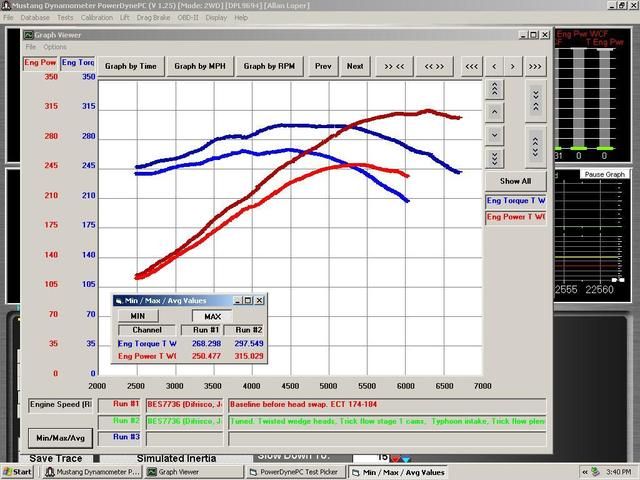 Our newest tune-of-the-week is a before and after comparison of a 1999 Mustang GT that we installed a set of Twisted Wedge cylinder heads and Trick Flow Stage 1 camshafts on. Before the head & cam swap, the car had already been tuned by Realspeed and was equipped with Typhoon intake manifold, Professional Products 73mm throttle & plenum, free flowing exhaust and a homemade cold air intake tube with a small cone filter. Our baseline dyno test before the head-swap resulted in 250 rear wheel horsepower and 268 ft/lb torque. After baseline testing, we installed Trick Flow Twisted Wedge heads and Trick Flow stage 1 cams. The injectors were also upgraded to new 24-lb/hr units to keep up with the fuel demands from the more powerful cylinder heads. All other parts remained the same. Back on the dyno, several test runs were made to map out the ignition timing and air/fuel ratio settings that worked best with the new valve layout and combustion chamber shape of the Trick Flow heads. The finished tune resulted in 315 rwhp and 297 ft/lb torque. That’s a gain of 65 rwhp and 29 ft/lb from the heads and mild stage 1 cams. Some additional thoughts about the cylinder head results: This car was equipped with an un-ported Typhoon intake. While better than stock, we believe this intake may still be limiting the potential of the Twisted Wedge heads. Porting this intake or switching to a P51 or Trick Flow Track Heat manifold would have likely resulted in even more power. Similarly, the small cone filter on the end of the homemade air intake flowed enough air for the stock heads, but with the better flowing Twisted Wedge heads and cams it was likely a slight restriction. Switching to a better air intake may have resulted in more power. Overall, we are impressed with the Twisted Wedge heads and feel they have a lot of potential. 5/8/10  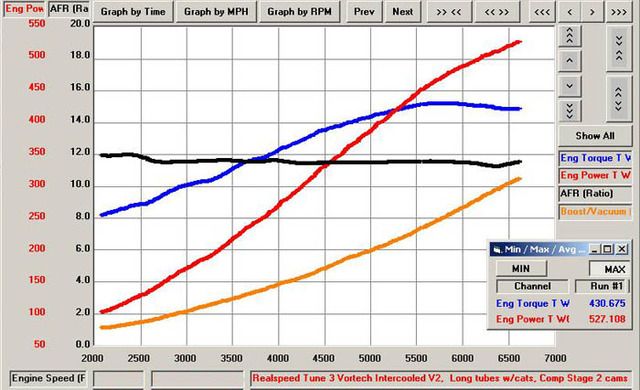
This week’s tune-of-the-week is 2007 Mustang GT with an intercooled Vortech S-trim supercharger kit, cams and long-tube headers with catalytic converters. The only other non-stock parts on the car were a set of SLP mufflers. With just these modifications the car put down an astounding 527 rear wheel horsepower on 93 octane pump gas. That’s 248 horsepower more than the last stock 2007 Mustang we tested. In fact, the power came so easily on this car that we were not even close to maximizing the power potential before it was decided to “de-tune’ the car for the sake of durability with the stock pistons and rods. As you can see from the dyno graph, power was still climbing rapidly when the dyno pulls were stopped at 6700 rpm. Had we pushed the car to it’s fullest potential, 560 rwhp would have been the likely result! So what makes this car so special? Not much, really, except the right combination of well matched components. Read below for a few notes about what was different about this car. Years of experience with Vortech superchargers taught us that centrifugal superchargers respond very well with cams designed for naturally aspirated engines. (Contrary to popular wisdom that says you MUST have a custom blower cam). With that in mind, after talking with the customer about his particular needs we recommended Comp Cams’s Stage-2 naturally aspirated cams to replace the cams he had previously installed. Amazingly, the 39 lb injectors supplied with the Vortech kit were able to support over 530 rwhp. In contrast, many cars that are working harder - turning the supercharger faster for more boost with less efficient exhaust flow and with stock cams - run out of fuel with 39 lb injectors at just 470 hp. Realspeed’s Vortech supercharger kit includes a few extra goodies that we always do to make our installations work better, such as relocating the air temperature sensor after the intercooler, colder spark plugs and a custom tune. But other than that, nothing else special was done. The supercharger pulley (boost level) was the same standard pulley supplied by Vortech for all of their intercooled kits. For information about dyno tuning your car click here 3/26/10 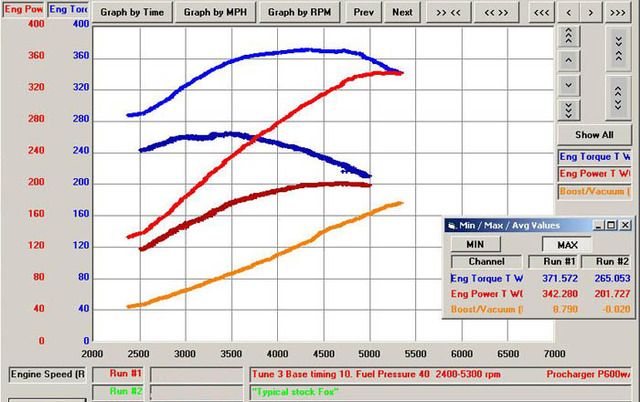 For this week’s tune of the week, Anthony added a Procharger supercharger to his high-mileage 1988 Mustang GT and got excellent results. Besides the supercharger and the switch to the 1989-1993 Mass Air computer, the car is remarkably stock. The only significant changes were roller rockers, shorty headers, an H-pipe and a cat back exhaust system. On our recommendation Anthony added a “Pro tube” blow thru MAF of the same diameter as the intake air tubing and a set of 42 lb injectors. After a tune by Realspeed the car produced 342 rear wheel horsepower and 371 ft/lb torque. We didn’t get a chance to dyno his car before the supercharger was added, but compared to a typical stock 87-93 Mustang Anthony’s car gained 140 rwhp and 106 ft/lb with just 9 lbs of boost and some free flowing exhaust. 3/17/10 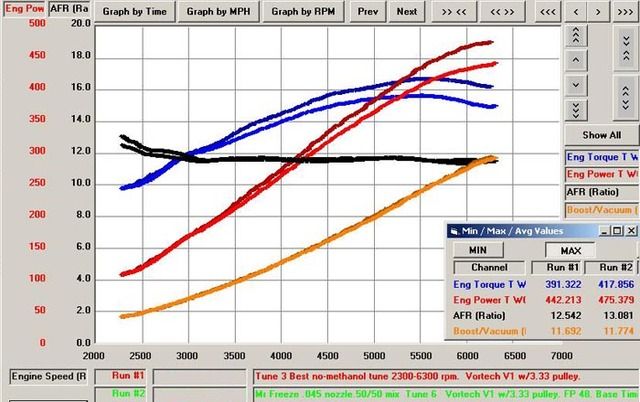 It's pretty well known that adding alcohol injection can add 50, 70, or even up to 100 HP on high-boost race cars running 25 lbs of boost or more. But what about the typical street car with a bolt-on supercharger running low boost? How much will alcohol injection help them? This week’s tune-of-the-week is a fairly typical Vortech supercharged 5.0 Mustang. It has the standard High Output V1 Vortech on it with the stock 6.87” crank and 3.33” upper pulley, a Power Pipe, 80mm MAF, Trick Flow heads and intake, a mild cam and 42 lb injectors. Tuning first without methanol resulted in 442 rwhp, 391 torque and 11 lbs of boost at 6000 rpm, which is typical for this combination. Also fairly typical, the fuel injectors were maxed out at 98% duty cycle by 6000 rpm. Next, we connected the Mr. Freeze alcohol injection kit and filled it with a 50/50 mix of water and methanol. Retuning for the methanol resulted in a gain of 33 hp, up to 475hp and 417 torque at the rear wheels. Running the Mr. Freeze not only increased the power, but it did so without having to resort to bigger fuel injectors, a stronger fuel pump, or increased boost, all of which would have been required without the Mr. Freeze alcohol injection 2/24/10  Have you ever wondered what adding a stroker kit would do for your engine’s horsepower and torque? Answering that question accurately can be tricky because there are so many variables, such as “Is the car supercharged or naturally aspirated?” and “Are the cylinder heads or cam going to be upgraded at the same time?” The answers to these important questions can change the power considerably. So here is just one example to give you and idea of what can be expected. Eddie’s ’93 Notchback was originally built with a Vortech V2 supercharger, unmodified-out-of-the-box Twisted Wedge cylinder heads, an Anderson B31 cam and Edelbrock Performer RPM intake manifold. Using an Anderson Power Pipe and the “stock” Vortech 3.33 inch pulley, the car put down an impressive 500 rear wheel horsepower and 451 ft/b torque on Realspeed's Mustang Dyno. Searching for even more power, Eddie installed a World Products Man-O-War 371 cubic inch short block. The short-deck (8.2 inch “302” height) block was topped off with the same cylinder heads, intake and camshaft as before. The same 70mm throttle and EGR spacer were retained, as was the 80mm Pro-M Mass air meter. The shorty headers were replaced with long tube headers. The old engine had completely maxed out the old 42 lb injectors and fuel pump, so the fuel system was upgraded with a Glenn’s Performance dual pump and “sleeper tank” system with 60 lb injectors. To keep the boost from dropping with the new larger engine, the supercharger pulley was changed from 3.33” to a still-mild 3.12” pulley. This kept the boost level approximately the same. (At most engine speeds the boost was about a 1/2 lb lower with the new engine and pulley.) Back on the dyno the new 69 cubic-inch larger engine produced 588 rwhp and 571 ft/lb, an increase of 88 horsepower and 123 ft/lb torque. For information about dyno tuning your car click here 2/4/10 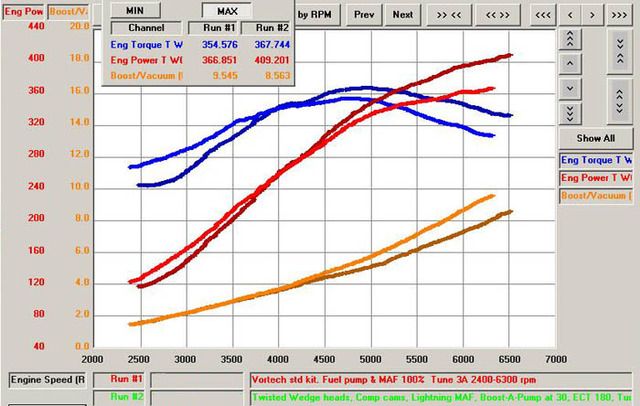 This week’s Tune Of The Week is our first comparison of the new 2-valve Twisted Wedge heads with cams on a 2003 Mustang GT. The car is supercharged with Vortech’s standard base-model kit. It has no power pipe, no intercooler, and uses the standard pulley that comes with the kit. With the stock heads it put down 366 rwhp, a respectable gain of about 110 horsepower over what a similarly equipped car would make without the supercharger. After the customer installed a set of Twisted Wedge heads and Comp Cams #XE270AH-13 cams, he brought it back to us for a re-tune. With the stock heads he had pretty much maxed out the MAF sensor and the fuel pump, so a Lightning MAF and Boost-a-Pump were also installed. Without changing any other parts, the car picked up 43 horsepower, to 409rwhp. Further gains would have been possible with aggressive tuning but the customer stressed that he wanted a conservative tune to be as safe as possible while maintaining good power. It should also be noted that power was still climbing at 6500 rpm. The test was stopped there because we deemed it to be the safe limit for the stock short-block assembly. With a built bottom-end and an aggressive tune, these heads look ready to make some serious power right up to 7000 rpm. The better flowing heads started showing the restriction of the “stock” Vortech air inlet at higher rpms, and the boost dropped compared to the stock heads. Switching to a Power Pipe would have brought more air to the supercharger, bringing the boost level back up and increasing power even more. Changing the supercharger pulley to bring the boost back up is also an option. But for this test all the hardware was left the same. 1/21/10 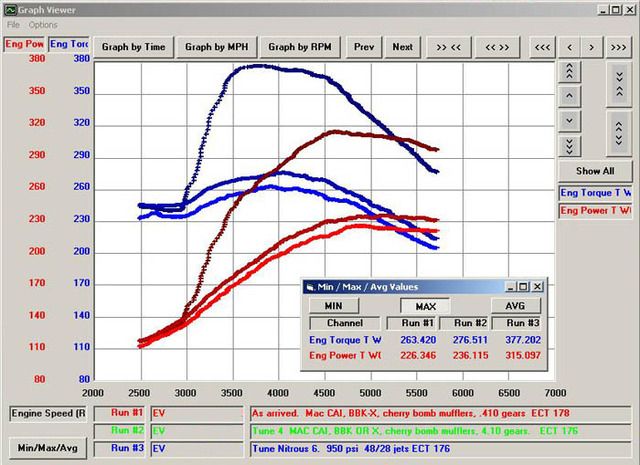 This week’s Tune Of The Week is a mostly-stock 2001 Mustang GT featuring minor bolt-ons and a nitrous oxide kit. Tuning the mostly-stock car gained 10 rear-wheel horsepower (without the nitrous) and snappier throttle response. When the car arrived it had no nitrous pressure gauge and no bottle warmer. Installing a gauge revealed the cold nitrous bottle only had 550psi even though the bottle was FULL. Installing a bottle heater brought the pressure up to the 950psi the kit was designed for and restored the performance that was lacking. A switch-chip was installed to allow for instantaneous changes to the tune for the best performance with or without the nitrous. With the nitrous oxide on the car gained 89 rwhp and 114 lb-ft of torque. 12/17/09 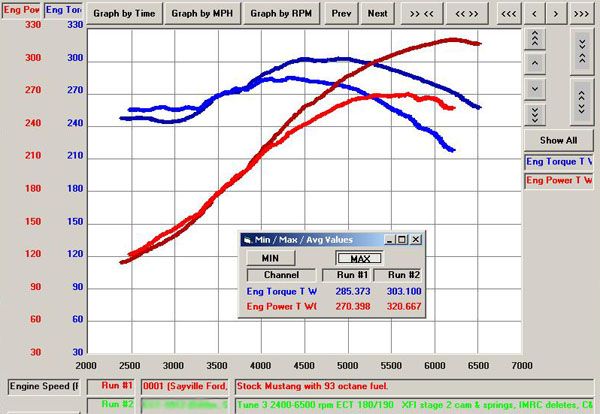 This week's tune of the week is a 2006 Mustang GT that we install stage 2 comp cams valve springs required and did a custom tune on the car. This car also had some minor bolt on such as a C&L cold air kit, shorty headers, high flow mid pipe and 4.10 gears. With all these modifications over stock this car gained 50 rwhp and 18 rwtq, with about 20-25 rwhp from the cams alone. For information about dyno tuning your car click here 12/3/09 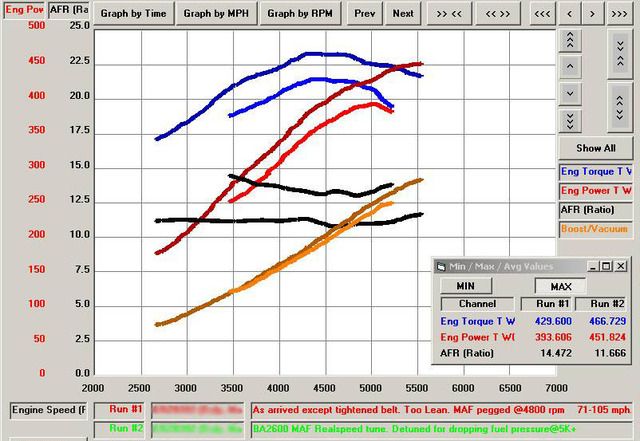 This week's tune of the week is a 1995 Ford Lightning with a Vortech supercharger. This customer came to Realspeed to have us just check out the current tune, when we found it to lean and the mass air meter pegging we installed a meter and had Dan do a custom tune. With the custom tune the Lightning gained 58 rwhp and 37 rwtq. Unfortunately the fuel pressure was dropping at high rpms so Dan was not able to push the Lightning to it's max potential power. 11/21/09 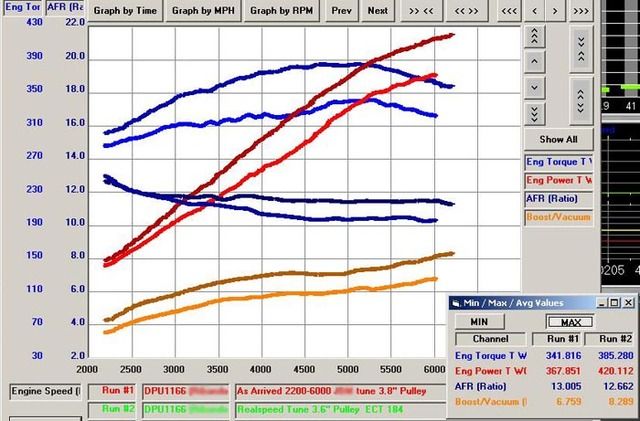 This week's tune of the week is a 2006 Saleen Mustang that came in with a mail order tune from a reputable company. The customer wanted to make as much power as he could with the stock fuel pump, but without pushing the limits of safety. We installed the next smaller size pulley going from a 3.8" to a 3.6" pulley. Dan had commented that the tune was decent for a mail order tune but the car was running rich and the timing was conservative which left some things to improve on. After a custom tune the car gained 53 horsepower & 41 torque at the rear wheels and 1.5lbs of boost. 11/10/09 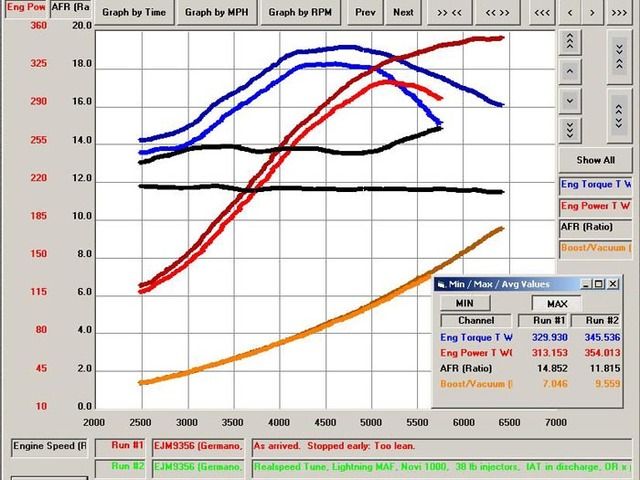 This week's tune of the week is a 2001 Bullitt Mustang that came in with a Paxon supercharger on it. This customer originally came in for a baseline test, to check the mail order tune from Paxton. Dan couldn't even run it all the way through the rpm range, due to how extremely lean this car was running. After a tune the car improved from the original 313rwhp to a very nice 354rwhp. That's a 41 rwhp gain and the car is much safer with a nearly perfect 11.8 air/fuel ratio. | ||
| www.realspeedauto.com Ph.631-563-7325 All parts listed are for the Ford Mustang unless otherwise noted. Copyright 2018 Realspeed Automotive Inc. All rights reserved. |